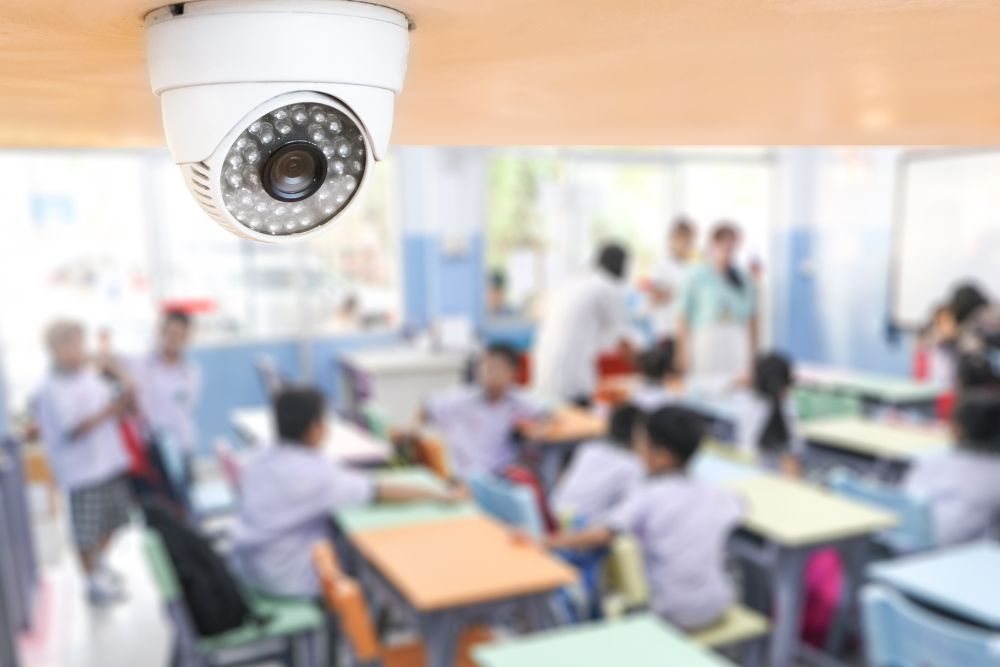Top 4 School Security Tech Trends of 2025
In a recent school pilot, a robot patrolled Santa Fe High School around the clock to survey the sprawling campus for potential threats and send messages to authorities—even enabling a remote security team to question an intruder.

Robots on school grounds are only one of many ways that American schools can keep students, staff, and property safe.
Surveillance cameras already cover 94% of higher-ed institutions, K-12 schools, and healthcare facilities, but now, American schools are rightfully upping the ante for school security with futuristic technology in the wake of vandalism from school protests and decades of school shootings. According to a study published in the Journal of the American Medical Association, more armed staff isn’t the answer, causing fear rather than feelings of security.
But knowing which technology to invest in is a big question in the booming school and campus security market, which is projected to grow more than 11% between 2024 and 2032. According to industry research, 75% of chief security officers (CSOs) surveyed say choosing the right security tools or solutions for their company is becoming increasingly complex.
Facilities Management Advisor sifted through 2025 school security trends to identify the top four technologies on the market.
1. Digital Twin Facility Layouts
Revealing security weaknesses on campus is key before adding additional layers of security. “Digital twin” technologies can recreate the layouts of real, physical spaces in a 3D, interactive software—which can help school officials pinpoint what areas need to be addressed by security tools—or even assist first responders in understanding where to go in an emergency.
2. Smart Sensors
Want to be alerted of potentially dangerous situations faster? Smart sensor technology can detect abnormal noises, such as car alarms, glass breaking, or even spoken requests for help. These sensors use audio and video feeds processed by artificial intelligence (AI) and machine learning to identify, analyze, and report on abnormalities.
Air sensors can also detect vape smoke or abnormal crowd sizes without the need for staff to monitor every corner.
3. AI-Powered Technology
Unsurprisingly, AI is the next forefront of school security technology.
The use cases for the technology are manifold. AI and machine learning can analyze audio and video feeds, track movement to discern horseplay from fighting, identify out-of-the-norm objects, and detect potential security threats that might have gone undetected through other methods.
Entry scanning solutions that are powered by AI can also identify weapons while reducing the need for frequent confrontations and can improve entry speed. A manufacturer of AI-powered visual gun detection technology says it takes less than a second for the system to detect a gun before it sends images and a precise location of the threat to personnel that are authorized to verify it. Once it’s confirmed, first responders are notified within seconds, and automatic lockdowns can kick-start.
From early 2022 to just over a year later, AI-powered visual gun detection technology sales increased by 2,000%.
4. Biometrics
On the heels of AI’s popularity is biometrics; 40% of CSOs said they were planning to invest in these systems over the next five years, according to the World Security Report 2023.
Schools can employ biometrics in various ways, from face recognition to fingerprint scanning, to control access to buildings. However, to circumvent security concerns, these biometrics can be combined with mobile device access. This allows visitors to use biometric recognition on their phones as two-factor authentication, which is already a norm, instead of requiring facilities to handle sensitive data.
Technology as Part of a Larger Security Ecosystem
Drones and cloud-based security systems were the runners-up in the trending technologies category, but they didn’t generate as much buzz as the other trends.
While the promises of enhanced security capabilities are exciting, experts are clear that new innovations aren’t foolproof. These systems may set off false alarms, create cloudy conditions of privacy, or serve up pixelated image resolution.
Security experts recommend that school systems evolve and advance policies and protections, adopt new technology, and consider security technologies part of a unified ecosystem that supports safety.
Ali Hickerson is a freelance journalist, content writer, and strategist based in Brooklyn, N.Y. Outside of Facilities Management Advisor, Ali’s recent bylines on health and workplace issues have crisscrossed the country and helped advocate for programs and policies that work to create a healthier, more humane, and equitable world.
The post Top 4 School Security Tech Trends of 2025 appeared first on Facilities Management Advisor.

